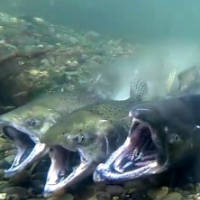Dismal Chinook Salmon Run Brings State Extinction Closer
 Chinook salmon (photo: Ken Davis, Wildlife Survey & Photo Service)
Chinook salmon (photo: Ken Davis, Wildlife Survey & Photo Service)
El Niño did not come early enough to save the winter Chinook salmon run in the Sacramento River this year, not that anyone really thought it would.
A couple centuries ago, an estimated 2 million of the fish spawned in the Central Valley, but those days are long gone. Last year, 95% of the Chinook salmon population failed to make it through the run and this year may have been the coup de grâce. The National Marine Fisheries Service (NMFS) said a similar 5% of the fish made it, pushing the endangered species to the brink of extinction in the state.
NMFS spokesman Garwin Yip told the San Francisco Chronicle, “We think it is temperature-related.”
Snowpack in the Sierra Nevadas has largely disappeared, so there is less cold water flowing into Lake Shasta. “There wasn’t as much cold water as anticipated and the water wasn’t as cold as we thought it was going to be,” Yip said. The release of water from Shasta Dam was to get the Sacramento River down to 56 degrees to accommodate spawning.
They didn’t make it. The temperature rose to 58 degrees.
Preliminary estimates indicated if the temperature had been lower, the juvenile count would have been higher than last year. The adult spawning count by NMFS was up 22% over the year before. The adults were laying eggs. But the juvenile count ended down 22%.
The juvenile count this winter was 217,489, compared to 279,952 the year before. Those numbers are dwarfed by the 8.5 million counted in 2005, when it was said that fishermen could just reach into the water and grab them. The count was 4.4 million in 2009.
The salmon that are born in the Sacramento River pass through the San Francisco Bay on their way to the ocean, only to return in three years to spawn. There are at least seventeen distinct runs of Chinook salmon in California. Four of them are in the Sacramento-San Joaquin River system and the winter run is considered the largest.
Since the salmon return after three years, a third bad year in a row in 2016 could spell extinction for them in California. Chinook, a mainstay of California’s $1.4-billion salmon fishing industry, vie for water with agricultural interests upstream.
Golden Gate Salmon Association (GSSA) Executive Director John McManus blamed federal officials back in July for the impending disaster when the State Water Resources Control Board warned, “The situation is grim for everyone and everything. The winter-run Chinook salmon may not survive losses in the Sacramento River similar to last year. At the same time, the situation is dire for California’s urban water users and agricultural communities.”
The association was pissed off because they thought a plan crafted on May 14 to keep Shasta Lake cold enough was doomed from the start.
“The equipment used by [the federal Bureau of] Reclamation to estimate the amount of cold water in Shasta Reservoir was later determined to have provided inaccurate data,” the board announced in a June press release (pdf). “In late May, additional temperature measurements by Reclamation pointed to warmer than expected water in Shasta Reservoir.”
The bureau gave up on May 29 and admitted it couldn’t hit the target temperature of 56 degrees.
McManus wrote in an op-ed that the bureau said there wasn’t inaccurate data, but rather, the bureau couldn’t believe the temperature recordings were as high as they were in April because it didn’t fit their modeling for what it should be. McManus said the model was off two to four degrees in 2014.
–Ken Broder
.
To Learn More:
Feds: Winter Salmon Run Nearly Extinguished in California Drought (by Ryan Sabalow, Dale Kasler and Phillip Reese, Sacramento Bee)
California Drought Puts Chinook Salmon in Danger of Extinction (by Ellen Knickmeyer, Associated Press)
Drought-Driven Salmon Deaths Could Have Far-Reaching Impact (by Peter Fimrite, San Francisco Chronicle)
Not Enough Being Done for Salmon (by John McManus, Golden Gate Salmon Association)
Massive Fish-Lift Trucks Drought-Constrained Salmon to the Bay (by Ken Broder, AllGov California)
- Top Stories
- Controversies
- Where is the Money Going?
- California and the Nation
- Appointments and Resignations
- Unusual News
- Latest News
- California Forbids U.S. Immigration Agents from Pretending to be Police
- California Lawmakers Urged to Strip “Self-Dealing” Tax Board of Its Duties
- Big Oil’s Grip on California
- Santa Cruz Police See Homeland Security Betrayal in Use of Gang Roundup as Cover for Immigration Raid
- Oil Companies Face Deadline to Stop Polluting California Groundwater





